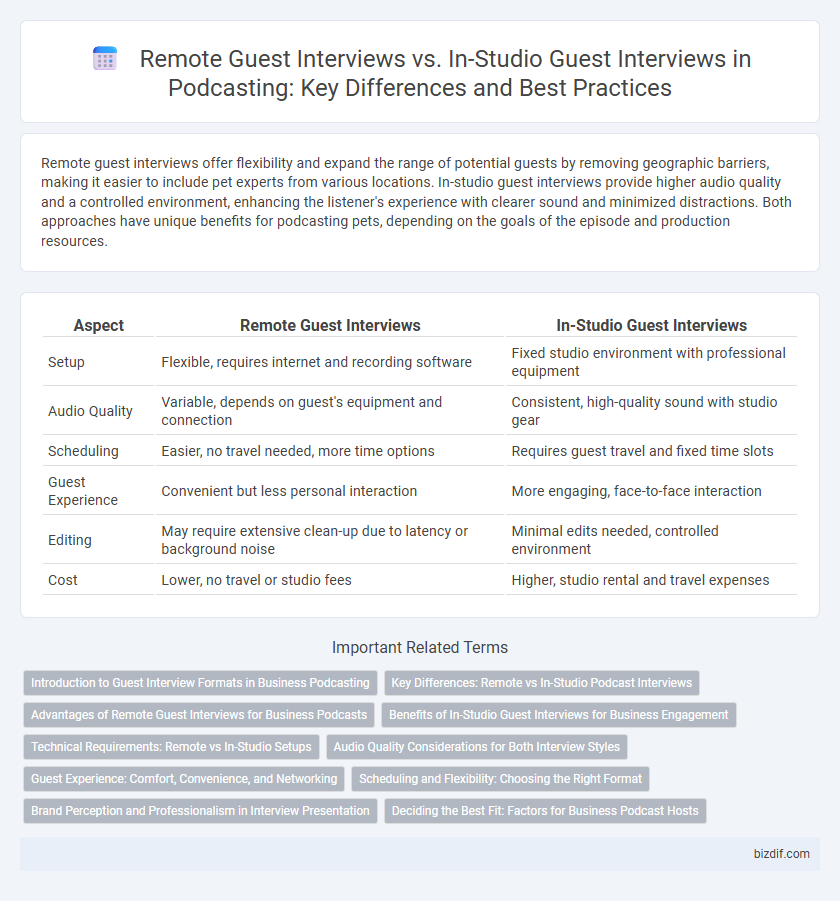Remote guest interviews offer flexibility and expand the range of potential guests by removing geographic barriers, making it easier to include pet experts from various locations. In-studio guest interviews provide higher audio quality and a controlled environment, enhancing the listener's experience with clearer sound and minimized distractions. Both approaches have unique benefits for podcasting pets, depending on the goals of the episode and production resources.
Table of Comparison
| Aspect | Remote Guest Interviews | In-Studio Guest Interviews |
|---|---|---|
| Setup | Flexible, requires internet and recording software | Fixed studio environment with professional equipment |
| Audio Quality | Variable, depends on guest's equipment and connection | Consistent, high-quality sound with studio gear |
| Scheduling | Easier, no travel needed, more time options | Requires guest travel and fixed time slots |
| Guest Experience | Convenient but less personal interaction | More engaging, face-to-face interaction |
| Editing | May require extensive clean-up due to latency or background noise | Minimal edits needed, controlled environment |
| Cost | Lower, no travel or studio fees | Higher, studio rental and travel expenses |
Introduction to Guest Interview Formats in Business Podcasting
Remote guest interviews in business podcasting enable access to a diverse range of industry experts regardless of location, leveraging high-quality audio platforms for seamless communication. In-studio guest interviews offer controlled environments with superior sound quality and real-time interaction, enhancing the listener's experience with dynamic conversations. Choosing between remote and in-studio formats depends on factors such as guest availability, technical resources, and desired production values.
Key Differences: Remote vs In-Studio Podcast Interviews
Remote podcast interviews offer flexibility by allowing guests to participate from any location, reducing travel costs and scheduling constraints. In-studio interviews provide superior audio quality and more control over technical equipment and sound environment, ensuring a professional listening experience. Both formats influence audience engagement differently, with remote setups relying on reliable internet connectivity and in-studio sessions benefiting from direct interaction and real-time adjustments.
Advantages of Remote Guest Interviews for Business Podcasts
Remote guest interviews offer unparalleled flexibility, enabling business podcasts to access industry experts from around the globe without geographical limitations. This approach significantly reduces production costs by eliminating travel and studio rental expenses while maintaining high audio quality through advanced recording software. Leveraging remote interviews enhances content diversity and scheduling convenience, ultimately optimizing the podcast's reach and impact in the competitive business landscape.
Benefits of In-Studio Guest Interviews for Business Engagement
In-studio guest interviews foster stronger business engagement through higher audio quality and controlled recording environments, enhancing listener experience and professionalism. These sessions facilitate real-time interaction and non-verbal communication, boosting rapport and authenticity between hosts and guests. The focused setting allows for dynamic discussions and seamless collaboration, promoting deeper connections with the audience and potential clients.
Technical Requirements: Remote vs In-Studio Setups
Remote guest interviews require reliable internet connections, high-quality microphones, and user-friendly recording software to ensure clear audio despite potential bandwidth limitations. In-studio guest interviews benefit from professional-grade equipment, controlled acoustics, and direct audio mixing capabilities, resulting in superior sound quality with minimal latency. Technical setups for remote interviews often involve troubleshooting connectivity issues, whereas in-studio setups emphasize soundproofing and hardware calibration for optimal audio fidelity.
Audio Quality Considerations for Both Interview Styles
Remote guest interviews often face challenges such as internet latency, background noise, and inconsistent microphone quality, which can degrade overall audio fidelity. In-studio guest interviews typically benefit from controlled acoustic environments, professional-grade microphones, and direct sound capture, ensuring superior audio clarity. Implementing high-quality recording software and post-production tools can significantly improve audio quality for remote interviews, narrowing the gap between the two formats.
Guest Experience: Comfort, Convenience, and Networking
Remote guest interviews offer unparalleled comfort and convenience by allowing guests to join from familiar environments without travel constraints, enhancing their overall experience. In-studio guest interviews provide immersive networking opportunities and a controlled setting with professional equipment, fostering deeper connections and richer interactions. Balancing these factors influences podcast producers' choices to optimize guest satisfaction and engagement.
Scheduling and Flexibility: Choosing the Right Format
Remote guest interviews offer unmatched scheduling flexibility, allowing participants from different time zones to join without travel constraints. In-studio interviews demand coordinated schedules and physical presence, often limiting availability but enabling higher audio quality and direct interaction. Selecting the right format depends on balancing convenience and production standards based on podcast goals.
Brand Perception and Professionalism in Interview Presentation
Remote guest interviews offer flexibility and access to diverse voices, yet they can face challenges in audio quality and visual consistency that may impact brand perception. In-studio guest interviews typically provide controlled environments ensuring superior sound and video clarity, reinforcing professionalism and enhancing the host's credibility. Consistent high-quality production in interviews shapes audience trust and strengthens brand identity within the podcasting landscape.
Deciding the Best Fit: Factors for Business Podcast Hosts
Remote guest interviews offer flexibility and access to a broader range of experts regardless of location, making them ideal for business podcast hosts with tight schedules or diverse guest needs. In-studio guest interviews provide superior audio quality and controlled environments, which enhance listener experience and support brand professionalism. Factors such as budget constraints, technical setup, guest availability, and podcast production goals determine the best fit for optimizing content engagement and operational efficiency.
Remote guest interviews vs In-studio guest interviews Infographic

 bizdif.com
bizdif.com